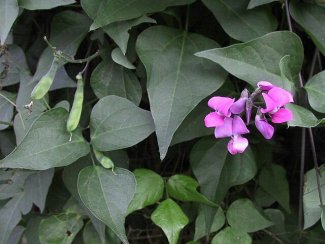South Africa - Cape Province
Listed as a perennial vine or herb; noted as a vine for the purposes of this screen. Dipogon lignosus is an herbaceous perennial with a climbing habit, becoming woody below. Its green softwood stems climb up nearby structures, shrubs or trees, sometimes growing more than 2 m tall and extending far sideways when given the chance. The leaves are pinnately trifoliolate (composed of three leaflets) and are a dark to medium green with a light underside. The leaflets are diamond-shaped, with a wide set base and and then tapering to a fine point. Each leaflet has its own stipule. Pink, mauve, magenta and purple peaflowers adorn the new growth on stemtips in short, dense racemes on long peduncles. Flowers occur throughout spring and summer (August to January). The fruits are flat, sickle-shaped pods, containing four to six seeds each, and form shortly after flowering. This fast growing twiner is evergreen in warmer climates, but may become deciduous in areas where frost occurs.
Dipogon lignosus is used in horticulture as a decorative climber. It survives more than one growing season, but some gardeners use it as an annual rather than a perennial. It is also planted as a natural soil enricher, as most legumes give home to nitrogen fixing bacteria in their roots nodules. Young pods can be eaten as a vegetable.
